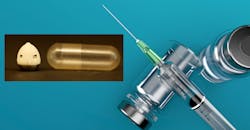Insulin Delivery Uses Hybrid Oral/Injection Approach
For almost a century, while patients with diabetes have relied on injections of insulin to manage their condition, researchers have been looking for a way to orally administer the drug.
Insulin injections are lifesaving and critical for many people, but they are unpleasant, cumbersome, and increasingly expensive for patients, so health care providers often delay prescribing insulin injections in favor of less-effective oral medications. A team of biomedical engineers from Harvard-affiliated Brigham and Women’s Hospital, MIT, and Novo Nordisk have now developed an ingestible microneedle that injects insulin into the stomach lining, and the device has been tested on large animals.
The ingestible microneedle is swallowed then it injects insulin into the stomach lining. For size comparison, it is placed next to a capsule. (Courtesy: Diana Saville/BWH)
The team built a self-orienting millimeter-scale applicator dubbed Soma. It is roughly the size of a pea and houses a needle made of insulin. Injection into the stomach lining is controlled by a spring held in place by a sugar disc. The disc breaks down under the humidity in the stomach and serves as the trigger for the micro-injection. The solid insulin needle lets the small device a sufficient dose of the drug. Soma’s size and material composition are similar to other FDA-approved ingestible devices.Drugs injected into the stomach wall quickly get distributed throughout the body. Moreover, the stomach is insensitive to sharp pains and tolerant of small, sharp objects.
The team had to overcome several engineering challenges, including navigating extremes in pH, thick mucus layers, and temperature, as well as reliably orienting the microneedle to inject into the stomach lining. To ensure the device would inject into the lining, the team modeled the Soma after the leopard tortoise, a species of that can flip itself over and onto its feet when on its back. Soma’s shape and density distribution are such that the microneedle lands in the stomach in the same orientation every time.
The Soma approach could also change drug development by providing a new way to deliver them. Current drug discovery efforts are aimed at creating small-molecule drugs patients can take orally. The principles underlying Soma could make it possible to give patients large-molecule drugs such as peptides, proteins, and nucleic acids.
The team still has a few challenges to overcome. For example, the animal tests only worked when the animals had been prevented from eating for up to 12 hours. It also need to carry out further research into the long-term effects of daily gastric injections.


